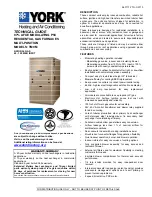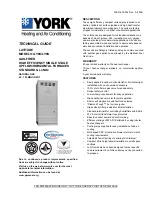
4
current revision of the National Fuel Gas Code (NFPA54/
ANSI Z223.1).
• Use only with type of gas approved for this furnace. Refer
to the furnace rating plate.
• Install this furnace only in a location and position as
specified on
.
• Provide adequate combustion and ventilation air to the
furnace space as specified on
.
• Provide adequate clearances around the vent air intake
terminal as shown in
,
, &
.
• Combustion products must be discharged outdoors.
Connect this furnace to an approved vent system only,
, &
• Never test for gas leaks with an open flame. Use
a commercially available soap solution to check all
.
• This furnace is designed to operate with a maximum
external pressure rise of 0.5 inches of water column.
Consult
,
, &
and the rating plate
for the proper circulating air flow and temperature rise. It
is important that the duct system be designed to provide
the correct flow rates and external pressure rise. An
improperly designed duct system can result in nuisance
shutdowns, and comfort or noise issues.
• When supply ducts carry air circulated by the furnace
to areas outside the space containing the furnace, the
return air shall also be handled by duct(s) sealed to the
furnace casing and terminating in the conditioned space.
.
• A gas-fired furnace for installation in a residential garage
must be installed as specified on
.
• This furnace is not approved for installation in mobile
homes. Installing this furnace in a mobile home could
cause fire, property damage, and/or personal injury.
The information listed below is for reference purposes only
and does not necessarily have jurisdiction over local or state
codes. Always consult with local authorities before installing
any gas appliance.
Combustion & Ventilation Air
• US: National Fuel Gas Code (NFGC), Air for Combustion and
Ventilation
Duct Systems
• Air Conditioning Contractors Association (ACCA) Manual
D, Sheet Metal and Air Conditioning Contractors National
Association (SMACNA), or American Society of Heating,
Refrigeration, and Air Conditioning Engineers (ASHRAE)
Fundamentals Handbook
Electrical Connections
• US: National Electrical Code (NEC) ANSI/NFPA 70
Gas Piping & Gas Pipe Pressure Testing
• US: NFGC and National Plumbing Codes
General Installation
• US: Current edition of the NFGC and the NFPA 90B. For
copies, contact the National Fire Protection Association Inc.,
Batterymarch Park, Quincy, MA 02269; or American Gas
Association, 400 N. Capitol, N.W., Washington DC 20001 or
www.NFPA.org
Safety
• US: (NFGC) NFPA 54–1999/ANSI Z223.1 and the Installation
Standards, Warm Air Heating and Air Conditioning Systems
ANSI/NFPA 90B.
Combustion Air Quality
CAUTION:
Combustion air must not be drawn from a
corrosive atmosphere.
To maximize heat exchanger life, the combustion air must be
free of chemicals that can form corrosive acidic compounds
in the combustion gases. The recommended source of
combustion air is to use outdoor air. However, the use of
indoor air in most applications is acceptable except as listed:
• If the furnace is installed as a single pipe installation
in a confined space, it is required that the necessary
combustion air come from the outdoors by way of attic,
crawl space, air duct, or direct opening. For Installations
in confined spaces, see
for combustion air
requirements.
• Installations in these locations may require outdoor air for
combustion, due to chemical exposures:
Commercial buildings
Buildings with indoor pools
Furnaces installed in laundry rooms
Furnaces installed in hobby or craft rooms
Furnaces installed near chemical storage areas
• Exposure to the following substances in the combustion
air supply may require outdoor air for combustion:
Permanent wave solutions
Chlorinated waxes and cleaners
Chlorine based swimming pool chemicals
Water softening chemicals
De-icing salts or chemicals
Carbon Tetrachloride
Halogen type refrigerants
Cleaning solvents (perchloroethylene)
Printing inks, paint removers, varnishes, etc.
Hydrochloric Acid
Cements and glues
Antistatic fabric softeners
Masonry acid washing materials
Heating Load
This furnace should be sized to provide the design heating
load requirement. Heating load estimates can be made
using approved methods available from Air Conditioning
Contractors of America (Manual J); American Society of
Heating, Refrigerating, and Air Conditioning Engineers; or
other approved engineering methods.
Excessive oversizing
of the furnace could cause the furnace and/or vent to
fail prematurely.
The ductwork should be appropriately sized to the capacity of
the furnace to ensure its proper airflow rating. For installations
above 2,000 ft., the furnace should have a sea level input
rating large enough that it will meet the heating load after
deration for altitude.





































